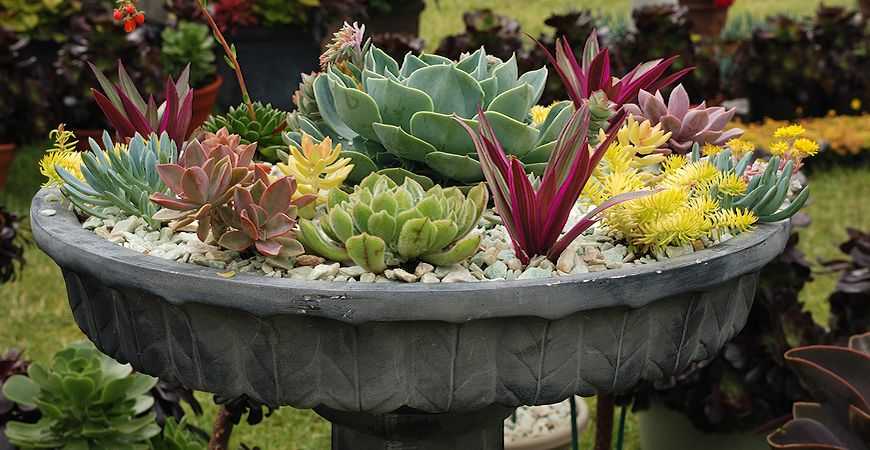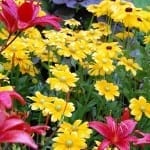
Check out these 4 Easy Steps to Creating a Beautiful Container Garden
Container gardens are compact, mobile showcases for beautiful blooms and striking foliage. You don’t have to be a master gardener or a landscape architect to craft a container garden that will be the perfect highlight for your outdoor space.
Use these 4 simple steps and create a container garden you and your family will love!
Why We Love Container Gardens
There are so many things to love about container gardens. They need little space, so they’re just right for even the smallest garden.
They’re mobile, so you can keep your container garden out by the side patio to enjoy while you’re relaxing, and then move it out to the back deck for your guests to enjoy during your next cookout. Container planting gives you complete control over soil composition and drainage, which are both keys for plant health and can be tricky to manage with conventional gardening.
Weeds aren’t such an issue with container gardening as they are with conventional gardening, and a container garden’s mobility means that you can bring it inside to protect your plants during harsh weather.
You can also enjoy your plants up close with a container garden because you can bring your favorite flowers right up onto your deck, while the rest of your garden is stuck rooted out in the yard. What’s not to love?
Step 1: Choose your Container
The first step to starting a container garden is choosing your container. Look at the space where you want to put your container garden and decide on the size and number of containers you would like to have.
Once you have the size and number of containers figured out, it’s time to go shopping. There are a lot of materials to choose from, but synthetic containers are more lightweight and easier to move around, hold in moisture longer than some natural materials such as terra cotta, and are easier to drill when it comes time to add drainage holes.
Many synthetic pots are made to look like natural materials and have a very attractive appearance.
Step 2: Choose your Plants
This is the fun part! There are so many ways to design your container garden.
To create an eye-catching display, gardener Dave Epstein recommends choosing three types of plants: what he calls a “thriller,” a “filler,” and a “spiller.” The “thriller” is a striking, eye-catching plant that is often taller than the others and brightly-colored.
The “filler” fills the center of the container and is usually a plant with attractive foliage, and the “spiller” has blooms or eye-catching foliage that spill out of the container. Trailing petunias (see photo above) makes an excellent “spiller.” The colors of the plants should either blend together and complement each other, or contrast and cause each other to “pop.”
One key thing to keep in mind when you’re choosing your plants for your container garden is that, because these plants will live in the same closed-in environment, you will need to choose plants that have the same sun and moisture requirements.
If you choose one plant that needs full sunlight and another that does best in partial shade, one of them is not going to do well, and the same goes for watering needs.
Step 3: Prepare your Container
Now that you’ve bought your containers, it’s time to prepare them. Here are some simple steps that gardener Dave Epstein recommends:
- Drill a hole in the bottom. Even plants that need plenty of water will develop root rot if they don’t get adequate drainage. If your container doesn’t already have a hole in the bottom for drainage, drill a hole that’s about ¼ inch in diameter in the center of the container’s bottom.
- Add rocks. A Thin layer of rocks on the bottom of the container will assist with drainage and will also prevent soil from falling out of the drainage hole. Add about an inch of gravel to the bottom of the container.
- Save on soil. Many containers are a lot deeper than the actual planting depth for your plants. If this is the case with your container, instead of wasting money filling the whole container with potting soil, you can put old plant pots upside-down in the bottom of the container to fill up the extra space, then put a layer of landscape fabric on top, and put the potting soil on top of the landscape fabric.
- Add potting soil. Dave Epstein recommends filling the container halfway with a lightweight potting soil, then working in a granular fertilizer.
Step 4: Plant your Garden!
Now that you’ve prepared your container, it’s time to plant your garden!
- Partially fill the container with soil. Add potting soil to the container until it is high enough that your plants can sit on top of it and almost have the top of their soil reach the top of the container.
- Loosen the roots. Remove the “thriller” from its pot, and very gently loosen the outside edges of the roots.
- Position the plants. Place the “thriller” in the back of the container if it’s taller than the other plants. Loosen the roots of the “filler” and the “spiller,” and place the “filler” in the center of the container, and the “spiller” in the front. Alternatively, you could place the “thriller” in the center and surround it with the “filler,” and place the “spiller” in the front.
- Water. Give your plants a thorough watering.
For a different sort of container garden, check out this helpful article from Midwest Living Magazine that has 14 ideas for easy container ideas using succulents. Succulents are a wonderful option if you live in a drought-prone area, or if you just don’t have the time to water your container garden frequently.
Take Care of your Container Garden
Now that you’ve created a beautiful container garden, you want to keep it healthy and looking its best. Here are the essentials for keeping your container garden thriving:
- Proper watering. Container gardens dry out much more quickly than plants that grow in the ground. The type of container makes a big difference: for example, the soil in a wooden container will dry out much more quickly than the soil in a synthetic container, because wood is porous. The soil in a clay container will dry out even more quickly. If your plants need damp soil, feel the soil in the morning to see if it feels damp below the surface. If not, water your container garden. Your container garden may need a second dose of water on very hot, dry days. You will get the hang of it after a while, and you’ll learn about how often your container garden needs a dose of water.
- Deadheading. Most flowers will benefit from regular deadheading, and reward you with more blooms. Plants also benefit when you trim away any other dead material.
- Fertilize. Plants need food, so a dose of a liquid fertilizer part-way through the season will help keep your container garden healthy.
About Winter Plant Care
When winter gets here, you will need to protect your container garden if you want to enjoy its beauty next year. Check the USDA Hardiness Zone for your container plants.
If they are not considered perennials for your zone, you will need to bring them indoors for the winter. If they are “barely” perennial for your zone, you will need to at least bring the container into the garage or basement for the winter to be on the safe side, because plants in containers don’t survive the cold as well as plants in the ground do.
If your plants are barely perennial in your zone and you don’t want to bring them indoors, another option is to bury them in your garden for the winter for protection.
Additional Information for Container Gardening Success
Here’s an indispensable resource from the University of Illinois Extension that’s loaded with everything you need to know about container gardening. It’s got information about several varieties, from topiaries to vines, to hanging baskets, and even water gardens.
It also has information about garden blueprints, selecting the right soil mix, fertilizing your container garden, overwintering your plants, and fighting garden pests and plant diseases.
Some “Gardens for your Garden”
We love container gardens, but you also have traditional garden space that’s waiting for the right flowers, trees, shrubs, or vegetables. Here are some of our favorite non-container gardens.
- Beautiful shade-loving plants to decorate your cool oasis. This post includes several options for your container garden!
- An exotic moon garden that pampers all 5 of your senses
- A scrumptious edible flower garden that brings delicious beauty to your table
- 7 Gorgeous climbing plants to bring color to your pérgola, arbor or trellis
- 7 vegetables that grow in the shade to maximize your gardening space
- 3 delicious additions for your vegetable garden
- 8 plants that attract butterflies and hummingbirds
Photos courtesy of Morning Ag Clips and Garden Lovers Club.
Stop by our website to learn more about our easy solutions to everyday problems, so you can spend less time cleaning and more time enjoying your garden!















